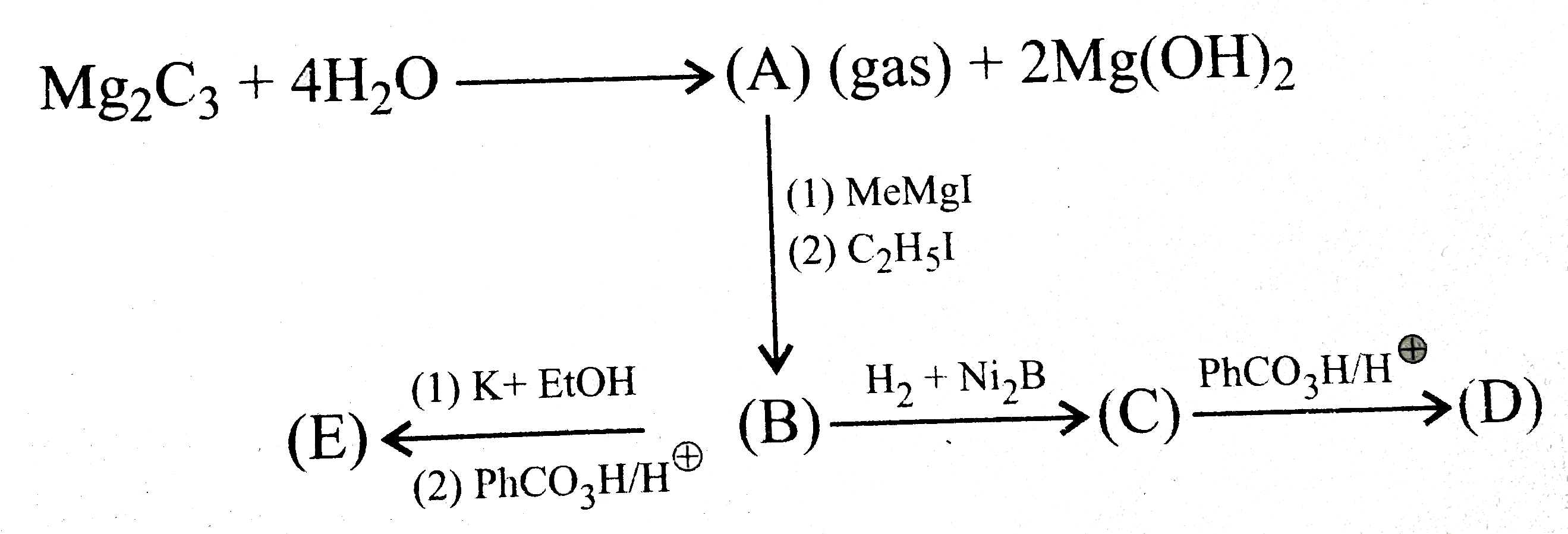An unknown aldehyde [A] on reacting with alkali gives β-hydroxyaldehyde which loses water to form an unsaturated but-2-enal. Another aldehyde [B] undergoes disproportionation reaction in the presence of conc. Alkali to form products [C] and [D]. The compound [C] is an aryl alcohol with formula C7H8O.
(i) Identify [A] to [B]. , (ii) Write the sequence of reactions involved.
(iii) Name the proucts when , [B] reacts with zinc amalgam and hydrochloric acid.
To solve the problem step by step, let's break down the information provided in the question and the video transcript.
Step 1: Identify Aldehyde (A)
The unknown aldehyde (A) reacts with alkali to form a beta-hydroxyaldehyde, which then loses water to form an unsaturated but-2-enal.
1. Aldehyde (A): Since the reaction involves forming a beta-hydroxyaldehyde and subsequently but-2-enal, we can deduce that (A) is likely to be acetaldehyde (CH3CHO).
2. Reaction with NaOH:
- When acetaldehyde reacts with NaOH, it undergoes aldol condensation to form 3-hydroxybutanal (the beta-hydroxyaldehyde).
- The structure of 3-hydroxybutanal is CH3-CH(OH)-CH2-CHO.
3. Dehydration:
- The beta-hydroxyaldehyde (3-hydroxybutanal) loses water (H2O) to form but-2-enal (CH3-CH=CH-CHO).
Step 2: Identify Aldehyde (B)
The second part of the problem involves another aldehyde (B) that undergoes disproportionation in the presence of concentrated alkali.
1. Disproportionation Reaction: This type of reaction involves the simultaneous oxidation and reduction of the same compound.
2. Given Information: The product (C) is an aryl alcohol with the formula C7H8O.
3. Identifying (B): The only aldehyde that fits this description and can undergo disproportionation is benzaldehyde (C6H5CHO).
- Benzaldehyde reacts with concentrated alkali to form benzyl alcohol (C6H5CH2OH) (C) and benzoic acid (C6H5COOH) (D).
Step 3: Write the Sequence of Reactions
1. For Aldehyde (A):
- Reaction: CH3CHO + NaOH → CH3-CH(OH)-CH2-CHO (3-hydroxybutanal)
- Dehydration: CH3-CH(OH)-CH2-CHO → CH3-CH=CH-CHO (but-2-enal)
2. For Aldehyde (B):
- Disproportionation: C6H5CHO + NaOH → C6H5CH2OH (benzyl alcohol) + C6H5COOH (benzoic acid)
Step 4: Products of Aldehyde (B) with Zinc Amalgam and HCl
When benzaldehyde (B) reacts with zinc amalgam in the presence of hydrochloric acid, it undergoes a Clemensen reduction.
1. Clemensen Reduction: The aldehyde group (CHO) is reduced to a methyl group (CH3).
- Reaction: C6H5CHO + Zn(Hg) + HCl → C6H5CH3 (toluene)
Final Answers
1. (i) Aldehyde (A) is acetaldehyde (CH3CHO), and aldehyde (B) is benzaldehyde (C6H5CHO).
2. (ii) Sequence of reactions:
- For (A):
- CH3CHO + NaOH → CH3-CH(OH)-CH2-CHO → CH3-CH=CH-CHO (but-2-enal)
- For (B):
- C6H5CHO + NaOH → C6H5CH2OH + C6H5COOH
3. (iii) When (B) reacts with zinc amalgam and hydrochloric acid, the product is toluene (C6H5CH3).
The unknown aldehyde (A) reacts with alkali to form a beta-hydroxyaldehyde, which then loses water to form an unsaturated but-2-enal.
2. Reaction with NaOH:
- When acetaldehyde reacts with NaOH, it undergoes aldol condensation to form 3-hydroxybutanal (the beta-hydroxyaldehyde).
- The structure of 3-hydroxybutanal is CH3-CH(OH)-CH2-CHO.
- The beta-hydroxyaldehyde (3-hydroxybutanal) loses water (H2O) to form but-2-enal (CH3-CH=CH-CHO).
The second part of the problem involves another aldehyde (B) that undergoes disproportionation in the presence of concentrated alkali.
2. Given Information: The product (C) is an aryl alcohol with the formula C7H8O.
3. Identifying (B): The only aldehyde that fits this description and can undergo disproportionation is benzaldehyde (C6H5CHO).
- Benzaldehyde reacts with concentrated alkali to form benzyl alcohol (C6H5CH2OH) (C) and benzoic acid (C6H5COOH) (D).
1. For Aldehyde (A):
- Reaction: CH3CHO + NaOH → CH3-CH(OH)-CH2-CHO (3-hydroxybutanal)
- Dehydration: CH3-CH(OH)-CH2-CHO → CH3-CH=CH-CHO (but-2-enal)
- Disproportionation: C6H5CHO + NaOH → C6H5CH2OH (benzyl alcohol) + C6H5COOH (benzoic acid)
When benzaldehyde (B) reacts with zinc amalgam in the presence of hydrochloric acid, it undergoes a Clemensen reduction.
- Reaction: C6H5CHO + Zn(Hg) + HCl → C6H5CH3 (toluene)
1. (i) Aldehyde (A) is acetaldehyde (CH3CHO), and aldehyde (B) is benzaldehyde (C6H5CHO).
2. (ii) Sequence of reactions:
- For (A):
- CH3CHO + NaOH → CH3-CH(OH)-CH2-CHO → CH3-CH=CH-CHO (but-2-enal)
- For (B):
- C6H5CHO + NaOH → C6H5CH2OH + C6H5COOH
3. (iii) When (B) reacts with zinc amalgam and hydrochloric acid, the product is toluene (C6H5CH3).
Similar Questions
Knowledge Check
Phenol reacts with acetone in the presence of conc. sulphuric acid to form a C15H16O2 product. Which of the following compounds is this product ?
A B
B C
C D
D
In the following sequence of reactions, products A, B, C, D, and E are formed:

View SolutionAn aldehyde reacts with KCN to form cyanohydrin. In this reaction
View SolutionWrite the name of the product formed and give balanced equation of the reaction when :
calcium is reacted with cold water
View SolutionAn alkali metal A gives a compound B (molecular mass = 40) on reacting with water. The compound B gives a soluble compound C on treatment with aluminium oxide. Identify A, B and C and give the reactions involved.
View SolutionGive the reaction of oxide of metal that reacts with acid and alkali to form salt and water.
View SolutionHow does halogens react with (a) water (b) alkali and (c) metals
View SolutionWrite the structures and names of the compounds formed when compound 'A' with molecular formula C7H8 is treated with Cl2 in the presence of FeCl3
View Solution
